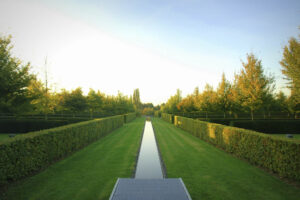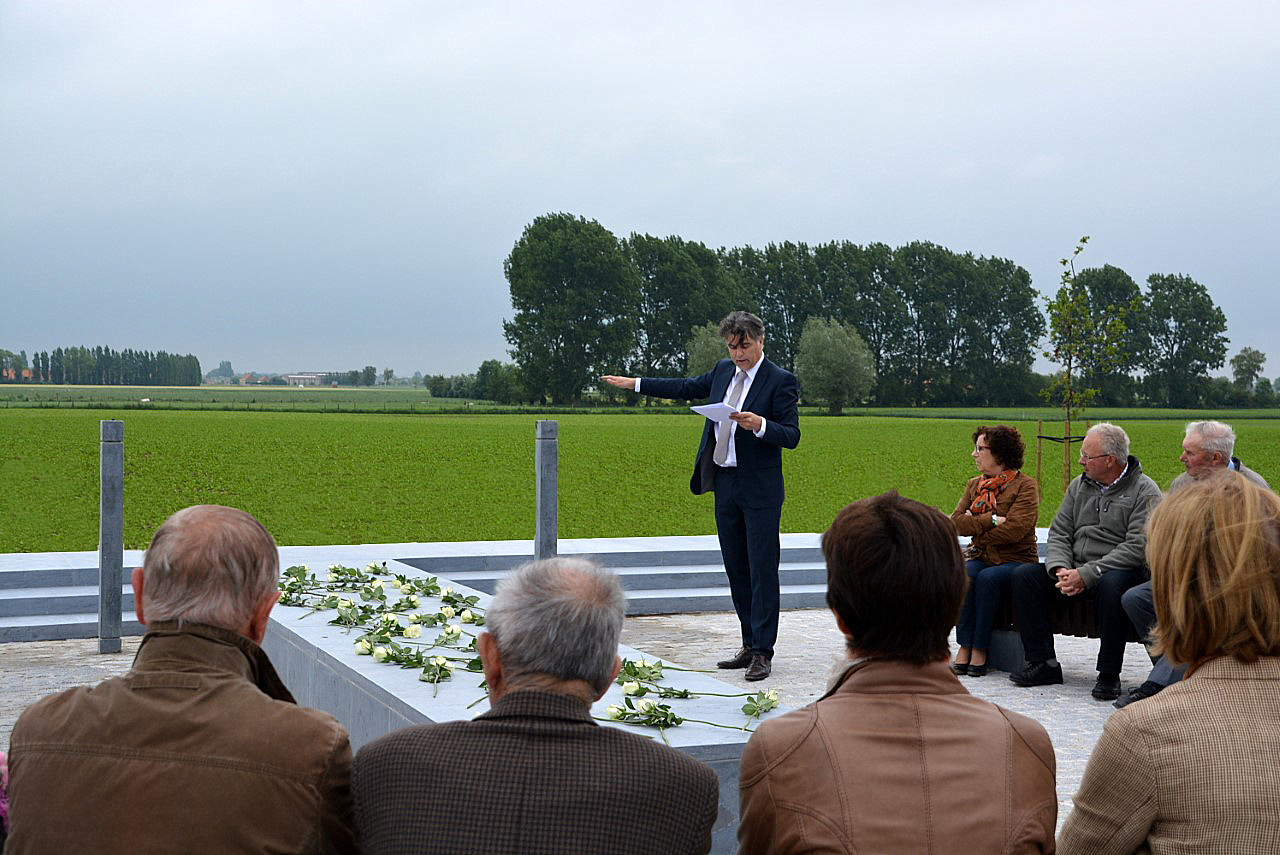THE FORMULA OF SILENCE
‘Quiet, … look!
Water, grass and trees.
A contemplative combination, the secret of the most beautiful garden, large or small. The formula of silence, which everyone should master.
A more beautiful living environment for all of us would become a reality!’
Andy Malengier, June 1, 2005

Wervik park cemetery – Photo Andy Malengier
Andy Malengier, born in Ypres on 9 June 1971, has a clear philosophy. His designs should have a positive effect on people’s state of mind and the further (re)design of outdoor spaces.
As a child, Andy had a constant fondness for nature, landscapes and drawing. At the age of 15, Andy moved to Ghent to take classes in the Artistic Humanities department of Sint-Lucas. There he was confronted not only with drawing and design, but also with architecture, design, art, painting, building models, etc … (read more under vision).
This education turned out to be a fantastic basis to later move to Melle, where he continued his studies at the Hogeschool Gent, Department of Life Sciences and Landscape Architecture.
Once he had his degree in higher education, Andy Malengier did not immediately opt for an independent life as a landscaper. He started working in some landscaping companies where he could gain practical experience. During this time, he combined his work with a postgraduate course at the Monuments and Landscape Department of the Academy of Arts in Antwerp.
These studies were discontinued early as he then had the opportunity to join the city of Wervik as deputy head of the urban green space department.
After 3 years, he took the step towards an independent existence and founded his own design agency.
His field of work is very broad. It embraces the design of private and public spaces from master planning to adjusting the last millimetres on site.
With his designs for cemeteries and memorials, he managed to distinguish himself effortlessly, witness the International Funeral Award (IFA) won in 1999 with the design for the park cemetery of Wervik. A unique achievement, as he was then able to leave behind the much-discussed realisation of the cemetery in Kortrijk, a design by Milanese architect Bernardo Secchi.
In the year 2000, Jan Hoet saw the model of the park cemetery in Wervik town hall and invited Andy Malengier to participate in the exhibition ‘Epiphany – Contemporary Art & Religion’ at Heverlee Park Abbey. Inspired by Ernst Haeckel’s nature studies, a strong geometric design of the Park Abbey’s cemetery extension was projected onto a large glass gate to temporarily replace the cemetery’s wooden gate.
In 2004, back won the IFA in the funerary art category, where his designs for a number of tombstones received an award.
He also won the IFA in 2007 with the realisation of 4 cemeteries for the municipality of Zonnebeke. Meanwhile, he received several commissions to study cemeteries all over Flanders.
Andy Malengier was laureate with the new cemetery in Vleteren and also won the design competition with his design for a new cemetery in Watou. Because of Watou’s status as an art village, his design for the new cemetery in Watou can be considered a worthy permanent artistic addition. There, he integrated the grave monument with the poem ‘death’ by poet Eddy van Vliet and placed it there as a window on the landscape. The monument was previously erected by Eddy van Vliet’s friend and poet Gwij Mandelinck, to a design by architect Stéphane Beel.
In 2009, to realise a memorial site for 600000 fallen and missing Latvians under Soviet rule, an international competition was organised by the Koknese Fund, with the support of UNESCO. The available site was an island located in the Daugava river, near Koknese in Latvia. At the invitation of Riga-based landscape architect Helena Gutmane, a concept was worked out with her. The competition was not won. Winning from a field of 207 candidates from 31 countries was therefore no mean feat. The design by Japanese landscape architect and Zen monk Shunmyō Masuno was chosen and implemented.
In 2011, Andy Malengier took the initiative to design a memorial to the two Australian brothers Jim and John Hunter. John Hunter was killed in the Third Battle of Ypres in 1917 and died in his brother Jim’s arms. After the design was drawn up, a non-profit organisation was set up to finance the monument. The memorial was given the name ‘Brothers In Arms Memorial’ and was built in Zonnebeke. This ambitious project was realised in collaboration with English artist Sören Hawkes, Australian sculptor Louis Laumen and Belgian letter artist Stéphanie Busard.
In 2013, a temporary art installation was realised at the park cemetery in Wervik as part of the art route ‘Grensverbeelding’. With the installation ‘Epekeina’, he then clarified there, in his now 14-year-old design of the park cemetery, the integrated deep human and mythical border image. Image and sound were inseparable in the art installation. The continuous playing of Tibetan singing bowls via a sound system gave visitors a transcendent experience.
In 2015, Andy Malengier was commissioned by the ‘Volksbund Deutsche Kriegsgräberfürsorge’ to provide the study for the landscape restoration the WWI German military cemeteries of Vladslo and Langemark.
In 2021, commissioned by ‘The Commonwealth War Graves Commission’ (CWGC), two design visions were drawn for the redevelopment of the ‘Canadian St Julien Memorial’ with the statue ‘The Brooding Soldier’ in Langemark and the ‘Malbork Commonwealth War Cemetery’ in Poland.
In the year 2023, both German cemeteries and ‘The Brooding Soldier’ were included on UNESCO’s World Heritage List.
He also realised remarkable grave monuments such as the grave monument for the Dominicans of Brussels in the cemetery of Zellik and, in the cemetery of Ruiselede, the grave monument for the Congregation Sisters of Our Lady of 7 Sorrows. Various funerary monuments were also realised in the cemeteries of Wervik, Marke and Drongen.
The farewell circle
A very important aspiration in his designs for cemeteries is to sit once more as family and friends in a circle around the beloved deceased during the very last gathering. The opened circle plays an important role in this. The family can sit in a circle around the beloved deceased during the final hour of farewell, symbolically holding him or her for a while and letting go at the same time. Through this architectural movement, the ritual of saying goodbye is performed in a way that we have long forgotten and is no longer adequately embodied in our society. The circle is a response to a diachronic need. A never-vanished human need for places where the ritual can take place. The rediscovery of this human need in the form of a landscaping or ‘land art’ design, has already been realised by Andy Malengier in numerous cemeteries in Flanders. The first farewell circle came in the year 2014 at the new Vleteren cemetery. He is thus considered a pioneer or re-discoverer of this specific ancient cemetery and memorial architecture.
Besides these awards and honourable commissions in the world of cemeteries, Andy Malengier was also able to win an important competition with the renovation of the village centre of Oostnieuwkerke. The design for the village’s redevelopment was literally ‘groundbreaking’ in which he proposed to the Staden town council to break up the roadway over a distance of about 100 metres. The integration of art is another example. Inspired by the philosophy of Jean-Paul Sartre, Andy Malengier determined the theme of the art competition there. In a chapter of his work, ‘Being and nothingness’, he addresses ‘the gaze of the other’ there. The two-part artwork by sculptor Maen Florin translates this philosophy and clarifies there the importance of a central open space as a place of encounter. In Oostnieuwkerke, the sculpture cannot exist without the park and the park cannot exist without the sculpture.
The redesign of Wevelgem’s municipal park was also voted best park realisation in Flanders in 2018.
Andy Malengier’s commissions are situated in all facets of garden and landscape architecture, where he always tries to understand the essence of the various sites and translate them into sustainable designs. These include residential development projects, corporate environments, holiday and adventure parks and gardens around schools and care homes. A selection from the many assignments are the design of the entrance and roof garden of the TVH Visitor Centre in Waregem and the master plan for the entire domain of the Sint-Amandus Psychiatric Centre in Beernem.
Numerous private gardens are also realised. From city gardens to large landscape gardens.
In 2023, Andy Malengier obtained the honourable assignment to renovate the Montméry castle garden in Ambazac near Limoges. The castle garden was realised in 1890 to a design by the famous American landscape architect Frederick Law Olmsted, designer of many major American city parks including New York’s Central Park.

Vleteren park cemetery inauguration – Photo Friedel Pil
‘The power of the discipline of garden and landscape architecture lies in the art of creating places that stimulate the senses, provide joy, encompass paradoxes, reflect traditions and engender expectations. These places have aesthetic qualities that are enduring and valued, independently of the specific economic and social conditions they are created from.’ – Sven-Ingvar Andersson (1927-2007), Swedish landscape architect and professor at the Royal Danish Academy of Fine Arts in Copenhagen (Source: ‘Lexicon van de tuin- en landschapsarchitectuur’ by Meto J. Vroom)
This wonderful definition of the true work of the garden and landscape architect is consistently applied in the drawing up of plans and the giving of advice concerning the (re)design of private and public outdoor spaces.

